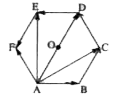ABCDEF is a regular hexagon. Find the vector →AB+→AC+→AD+→AE+→AF in terms of the vector →AD
−−→AB=−−→AD+−−→DC+−−→CB
−−→AC=−−→AD+−−→DC
−−→AD=−−→AD
−−→AE=−−→AD+−−→DE
−−→AF=−−→AD+−−→DE+−−→EF
−−→AB+−−→AC+−−→AD+→A+−−→AF=5−−→AD+2(−−→DC+−−→DE)+(−−→CB+−−→EF)
=5−−→AD+2→c(DO)+−−→DA
=5−−→AD+2−−→DA
=(5⋅2)−−→AD=3−−→AD.
Similar Questions
ABCDEF is a regular hexagon with point O as centre. Find the value of −−→AB+−−→AC+−−→AD+−−→AE+−−→AF

View SolutionABCDEF is a regular hexagon with point O as centre. Find the value of −−→AB+−−→AC+−−→AD+−−→AE+−−→AF

View SolutionABCDEF is a regular hexagon. Find the vector →AB+→AC+→AD+→AE+→AF in terms of the vector →AD
View SolutionABCDEF is a regular hexagon with point O as centre. Find the value of −−→AB+−−→AC+−−→AD+−−→AE+−−→AF

View SolutionABCDEF is a regular hexagon, Fig. 2 (c ) .65. What is the value of (vec (AB) + vec (AC) + vec (AD) + vec (AE) + vec (AF) ? .
View SolutionABCDEF is a regular hexagon with point O as centre. Find the value of vec(AB)+vec(AC)+vec(AD)+vec(AE)+vec(AF) .
View SolutionIn a regular hexagon ABCDEF, prove that −−→AB+−−→AC+−−→AD+−−→AE+−−→AF=3−−→AD
View SolutionConsider the regular hexagon ABCDEF with centre at O (origin). Five forces vec(AB), vec(AC), vec(AD), vec(AE), vec(AF) act at the vertex A of a regular hexagon ABCDEF. Then their resultant is
View Solution
